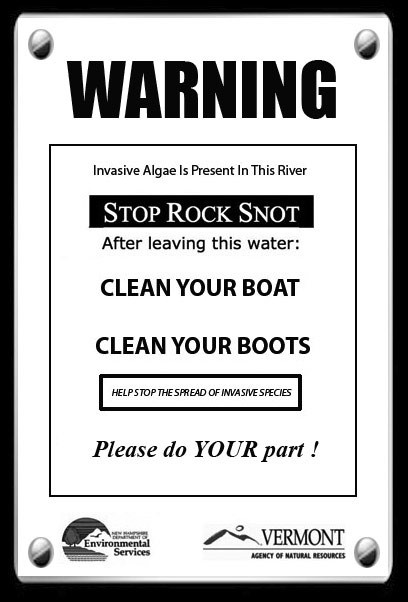
It’s late afternoon on a dog day of summer, and you’ve just finished a joyful canoe ride along the banks of a big pond shaded by hills and trees. Now it’s time to pull the Old Town from the water and head for home, because your neighbor has dibs on it – on another pond, later in the evening.
You lift the dripping craft from the water, muscle it to your shoulders, bang the back of the car twice, and then manage to aim for the carrier atop your vehicle. But wait! Hold everything! Have you checked for invasive plants? A leaf of one might be caught in the gunwales or wrapped around a paddle.
Environmental officials in New Hampshire and Vermont have been putting out the message these days that canoeists and kayakers, too, can be vectors in the spread of invasive, nuisance aquatic species. Eurasian watermilfoil, water chestnut, variable-leafed watermilfoil, fanwort, and didymo are among the concerns. There are also invasive animal species – zebra mussels and alewives, for example – to look out for, though they may be less likely to hitch a ride on a canoe.
With the possible exception of didymo, most of these ‘invasives’ are relatively new to our region. Without local endemic predation or other natural controls, they can grow with impunity, monopolizing water space and gobbling nutrients needed by native plants or animals.
Past warnings about invasive, or ‘exotic,’ species have been directed mostly at people who use motorboats. That’s because boat propellers, anchors, fishing lines, and boat trailers can easily snag a problem plant. A sprig or two might then be transported in the next few days to some unaffected body of water, triggering a new infestation.
More recently it was the anglers and water biologists who use felt-soled waders who were given the message. Felt waders are good vectors for didymo, the single-cell alga that has grown in clumps along the bottoms of some of our most popular rivers, smothering habitat for fish and aquatic insects. Also known as ‘rock snot’ because it looks gross, didymo is a turn-off for human swimmers.
Felt-soled waders – harder to clean and slower to dry than rubber waders – can pick up cells of didymo and transplant them to a new spot on a river or to a different river altogether. (A Vermont ban on felt-soled waders goes into affect on April 1, 2011.)
And now it’s the paddlers who are entering the spotlight. “I think more and more there is a realization that everyone has a role to play,” says Leslie Matthews, a scientist with the Vermont Department of Environmental Conservation. She says the appearance of didymo over the past few years has helped put the focus on canoeists and kayakers.
So, what was our friend at the pond to do before driving home?
Amy Smagula, coordinator for New Hampshire’s exotic species program, says he should at least have conducted a careful inspection. Any bit of plant life should have been pulled from the craft. “If it’s green, it may be mean, so take it off,” is her motto.
Ideally, a canoe should be allowed to dry for 48 hours before it’s used again. To kill zebra mussels or their larvae, the canoe should dry for a week. This, of course, would not have worked for our canoeist, because his boat was going out again that evening. To remedy this, he could have scrubbed the canoe and paddles with a water solution containing 10 percent bleach.
Matthews had a special recommendation for cold-weather paddlers: “We definitely encourage that their wetsuits be washed with soap and water and that they be left to dry for a couple of days.” She suggested that paddlers who portage bring along extra footwear for changing before entering new waters.
She acknowledged, though, that paddlers must travel a fine line between what’s ideal and what’s practical. Where to draw that line is now a topic at the Northern Forest Canoe Trail headquarters in Waitsfield, Vermont.
The 740-mile trail, connecting 79 rivers, lakes and ponds along its route from Old Forge, New York to Fort Kent, Maine, runs across northern Vermont and New Hampshire. It could be viewed as a potential corridor for invasive species.
Walter Opuszynski, trail director, says he’s been investing “quite a bit of time” lately trying to form a plan to help paddlers avoid spreading the unwanted plants and animals. The trail organization now offers information about invasive species in its literature and on kiosks at key spots along the trail
“We are trying to craft messages specifically for paddlers,” Opuszynski said. He stressed measures must be effective, but they must also “be things people are willing to do.”

